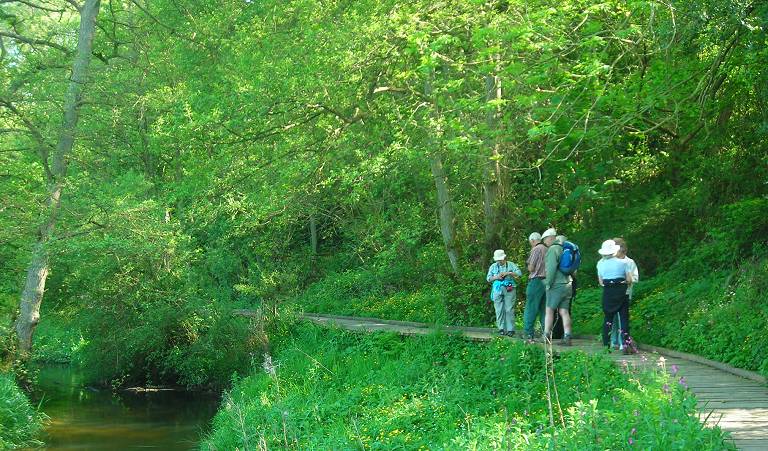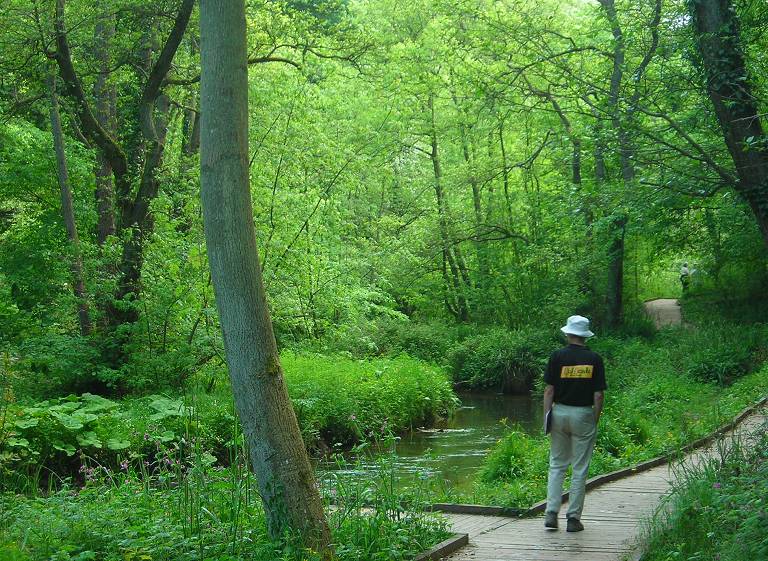
Some of the members debating the finer points of identification
Back to the Index page
About 14 members and guests joined Janet for a gentle walk along the riverside in Forge Valley (species lists below). Forge Valley Woods is a National Nature Reserve and “flanks the steep east and west facing slopes of the River Derwent valley. It is one of the best examples of mixed deciduous woodland in north east England.”. More information is available from English Nature’s website. The valley was cut rapidly by meltwater and the early Derwent at the end of the last Ice Age, when its previous outlet to the sea was blocked by ice (this is why the river gets to within about 4 miles of the sea at Scarborough but then goes all the way to the Humber south-east of York). Forge valley has steep sides which expose the geological strata, both sand- and limestones along with softer shale bands which often form a spring-line.

Some of the members debating the finer points of identification
We started from the car park towards the northern edge of the reserve amd walked first south along the riverbank, and then later retraced our steps and walked north to the edge of the woodland. This stretch of the valley is damp, more or less following the spring-line, but there is a boardwalk so access is very easy.
The birders were immediately attracted by a family of grey wagtails just by the bridge: well-grown youngsters were perched on a log in the water, being fed by their parents. This, and the sighting of a singing male redstart, were probably the highlights, although it was also very rewarding to see female blackcaps (who are, of course, “brownheads” – one could almost call them “redheads”) and a “willow-chiff” catching insects and bringing them to the (hidden) nest site. The consensus was that this bird was in fact a chiffchaff. I was also pleased to see a garden warbler, a very elusive little bird. We hoped to catch a glimpse of a kingfisher, dipper, or especially the lesser spotted woodpecker that is known to breed in these woods, but they were all hiding; I guess if one were to visit early in the morning before the many visitors who come here one would stand a better chance.
From a botanical point of view it was a very productive afternoon with plenty of variety from trees and shrubs through to ferns and water-plants such as the water crowfoot. I’m sure I missed one or two things, but still recorded almost 90 different species in a couple of hours. We were in the low-lying wetland with willow-alder carr for the most part, so did not see some of the limestone specialists which grow a little further up the slopes, such as herb paris and spurge laurel.
One of the things that surprised me in such a rich area was the species that were missing. There were almost no standard oaks, though there were several saplings: I suspect this is because the older oaks have been selectively felled – and this might explain the presence of numerous sycamores that shouldn’t really be in an ancient woodland, if they came in to fill the gaps when oaks were felled. I also saw no limes, which one might have expected. Much more surprisingly, I did not see a single birch. And under the trees, despite the damp ground, we saw no mint, nor marsh valerian, and only a little brooklime and one milkmaid/cuckoo flower. I also saw no St. Johns Worts though that might be because we were too early; no primroses or cowslips but we were probably too late and too low on the slopes; and no orchids – again we should probably have been a little higher on the dryer ground.
After a very enjoyable afternoon we thanked Janet for leading such a successful trip. Forge Valley is certainly well worth a visit for anyone interested in wildlife.

A typical view of the riverside woods
| Latin name | English name |
|---|---|
| Acer campestre | Maple, field |
| Acer pseudoplatanus | Sycamore |
| Ajuga reptans | Bugle |
| Allium ursinum | Ramsons |
| Alnus glutinosa | Alder |
| Alopecurus pratensis | Foxtail, Meadow |
| Anemone nemorosa | Wood anemone |
| Angelica sylvestris | Angelica |
| Anthriscus sylvestris | Cow parsley |
| Athyrium filix-femina | Lady Fern |
| Bellis perennis | Daisy |
| Caltha palustris | Marsh marigold |
| Cardamine amara | Bittercress, large |
| Cardamine flexuosa | Bittercress, wavy |
| Cardamine pratensis | Cuckoo flower or Milkmaid |
| Carex pendula | Drooping sedge |
| Carex riparia | Great Pond sedge |
| Carex sylvatica | Wood sedge |
| Chamaenerion angustifolium | Willowherb, rosebay or Fireweed |
| Chrysosplenium oppositifolium | Golden saxifrage, opposite leaved |
| Cirsium palustre | Thistle, marsh |
| Conopodium majus | Pignut |
| Corylus avellana | Hazel |
| Crataegus monogyna | Hawthorn |
| Crepis paludosa | Hawksbeard, marsh |
| Cruciata laevipes | Crosswort |
| Dactylis glomerata | Cocksfoot |
| Dryopteris affinis | Golden Scale Fern |
| Dryopteris dilatata | Common Buckler Fern |
| Dryopteris filix-mas | Male Fern |
| Epilobium hirsutum | Willowherb, great |
| Equisetum palustre | Marsh Horsetail |
| Equisetum telmateia | Great or Giant Horsetail |
| Eupatorium cannabinum | Hemp agrimony |
| Festuca gigantea | Fescue, Giant |
| Fraxinus excelsior | Ash |
| Galium aparine | Cleavers |
| Galium odoratum | Woodruff |
| Geranium robertianum | Herb Robert |
| Geum rivale | Avens, water |
| Geum sp. (G. × intermedium) | Avens, hybrid |
| Geum urbanum | Avens, wood |
| Glechoma hederacea | Ground ivy |
| Hedera helix | Ivy |
| Heracleum sphondylium | Hogweed |
| Hyacinthoides non-scripta | Bluebell |
| Iris pseudacorus | Yellow iris or Flag |
| Lathrea squamaria | Toothwort |
| Lonicera periclymenum | Honeysuckle |
| Luzula sylvatica | Woodrush, great |
| Lysimachia nemorum | Yellow pimpernel |
| Melica uniflora | Melick, Wood |
| Mercurialis perennis | Dogs mercury |
| Myosotis sylvatica | Forgetmenot, wood |
| Oxalis acetosella | Wood sorrel |
| Petasites hybridus | Butterbur |
| Phyllitis scolopendrium | Hartstongue |
| Poa annua | Meadow Grass, Annual |
| Poa nemorosa | Meadow Grass, Wood |
| Polystichum setiferum | Soft shield fern |
| Prunus spinosa | Blackthorn |
| Quercus sp. | Oak |
| Ranunculus pseudofluitans* | Water crowfoot |
| Ranunculus repens | Buttercup, creeping |
| Rorippa nasturtium-aquaticum | Watercress, common |
| Rosa canina | Rose, dog |
| Rubus fruticosus | Bramble |
| Rubus idaeus | Raspberry |
| Rumex acetosa | Sorrel, common |
| Rumex obtusifolius | Dock, broad leaved |
| Salix caprea | Willow, goat |
| Salix cinerea | Willow, grey |
| Sambucus nigra | Elder |
| Sanicula europaea | Sanicle |
| Silene dioica | Campion, red |
| Stellaria holostea | Stitchwort, greater |
| Stellaria uliginosa | Stitchwort, bog |
| Symphoricarpos albus | Snowberry |
| Taraxacum sp. | Dandelion |
| Teucrium scorodonia | Wood sage |
| Ulex europaeus | Gorse |
| Ulmus glabra | Wych Elm |
| Urtica dioica | Nettle, common |
| Valeriana officinalis | Valerian, common |
| Veronica beccabunga | Speedwell, brooklime |
| Veronica chamaedrys | Speedwell, germander |
| Veronica montana | Speedwell, wood |
| Viburnum opulus | Guelder rose |
| Vicia sepium | Vetch, bush |
| Viola riviniana | Violet, common dog** |
90 spp.
* This is the closest id I can get for the water crowfoot, growing in quite fast-flowing water in the river.
** I am not sure this violet wasn’t a hybrid as it had a thin, purplish spur only slightly notched.
Chiffchaff, Willow Warbler, Goldcrest, Grey Wagtail, Robin, Blackbird, Chaffinch, Blackcap, Wren, Rook, Jackdaw, Carrion Crow, Swift, Nuthatch, Garden Warbler, Great Tit, Redstart, Great Spotted Woodpecker, Green Woodpecker, Stock Dove and Woodpigeon. [Thanks to Jim Pewtress for the bird list.]
Andrew Grayson (our insect recorder) also sent this list
Butterflies
Gonepteryx rhamni (Brimstone), Anthocharis cardamines (Orange Tip), Inachis io (Peacock).
Flies
Rhagio scolopaceus, Empis rufiventris, Dolichopus popularis, Melanostoma scalare, Platycheirus clypeatus [s.s.], Platycheirus manicatus, Cheilosia albitarsis [s.s.], Cheilosia illustrata, Rhingia campestris, Brachyopa scutellaris, Melanogaster hirtella, Neoascia obliqua, Helophilus pendulus, Syritta pipiens.
Bumblebees
Bombus lucorum, Bombus pascuorum.
Damselflies
Calopteryx virgo, Enallagma cyathigerum.
| Back to the top and Index page |
Text and photos © Gill Smith 2008